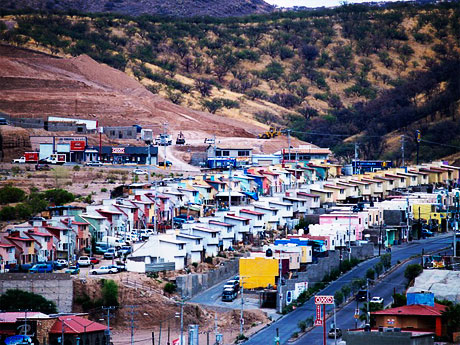- Australia and New Zealand
- East Asia and the Pacific
- Europe and Central Asia
- Albania
- Armenia
- Austria
- Azerbaijan
- Belarus
- Belgium
- Bosnia and Herzegovina
- Bulgaria
- Croatia
- Cyprus
- Czech Republic
- Denmark
- Estonia
- Finland
- France
- Georgia
- Germany
- Greece
- Hungary
- Iceland
- Ireland
- Italy
- Kazakhstan
- Kyrgyz Republic
- Latvia
- Liechtenstein
- Lithuania
- Luxembourg
- Malta
- Netherlands
- Norway
- Poland
- Portugal
- Romania
- Russian Federation
- Serbia
- Slovak Republic
- Slovenia
- Spain
- Sweden
- Switzerland
- Turkey
- Ukraine
- United Kingdom
- Uzbekistan
- Middle East and North Africa
- North America
- South Asia
- Sub-Saharan Africa
Home > Countries > Latin America and the CaribbeanMexico
Country Profile

Source: Government housing in Nogales, Mexico
Mexico’s population of 107 million people is more than 77 percent urban and approximately two-thirds of urban households own their home, while close to 20 percent are renters. The quality of the housing stock, while much improved over the last decade, is still problematic particularly in peri-urban and rural areas and the housing deficit still stands at a stubborn 8 to 9 million units. It affects mostly low income households that are informally employed (close to 30% of households) and have therefore no access to the dominant housing finance systems for private and public workers, i.e. Infonavit and Fovissste, which are labor tax funds for housing (employers contribute 5 percent of salaries into the fund) that provide loans to members, cross subsidizing the middle and lower income segments. There are also state owned housing finance institutions that provide subsidized loans to low-income households.
One of the main housing policy objectives of Mexican Government during the past decade has been to increase access to housing finance for middle and lower middle income households and increase formal housing production. That policy has two pillars; i) improve the performance of Infonavit as the largest of the two subsidized housing institutions providing subsidized finance to insured private sector workers, and ii) expand private sector participation in middle and lower middle income mortgage lending by providing upfront subsidies towards the down-payment of a mortgage loan to households that could not benefit from the agencies’ subsidized credit, mostly through Sofoles, non-bank specialized housing finance lenders. Sociedad Hipotecaria Federal (SHF) provides liquidity support and risk guarantees/insurance to stimulate securitization and designs the credit-linked subsidy instruments for private sector lenders. The upfront subsidy system and supply side support through SHF has recently been expanded to micro-lending for housing.
Impressive progress was made over the last decade in expanding mortgage lending in the middle and lower middle income market.Mexico’s residential mortgage market expanded on average by 14 percent per year between 2000 and 2008, as a result of macro-economic stability, SHF’s role as funder, guarantor and supporter of legal, infrastructure and products reforms for the sector, and the increase in access to funding through capital markets directly (securitization). Specifically Infonavit successfully improved its operations and extended its portfolio – it made a total of 3.6 million housing loans between 2000 and 2009, 66% of all mortgage loans. All loans are indexed on the minimum wage and low income loans benefit from both internal interest rate subsidies and upfront budgetary subsidies. This progress showed in the gradual increase in the construction of economic and moderate priced houses (units <M$500,000 were 69 percent of total production in 2009).
The private mortgage sector remains relatively small in the face of subsidized lending by the large public entities. It was also more affected by the recent economic downturn when access to capital markets dried up causing serious liquidity constraints – particularly for Sofoles, unemployment and informal sector employment increased, affecting default levels. As a consequence the dominance of Infonavit and Fovissste in the housing finance market has increased and so has the gap in access to finance between the formal sector workers and the informally employed lower income households who are excluded from the market but are 78% of the total number of households included in the housing deficit figures. Current policy efforts by Conavi and SHF focus on redressing these gaps, through i) incentives to increase the participation of alternative lenders who may serve this group; ii) and improved allocation of subsidies to benefit the informal and low income segment.Recent Updates
About the Editor
 Sociedad Hipotecaria FederalContact
Sociedad Hipotecaria FederalContact
WebsiteSociedad Hipotecaria Federal, S.N.C. (SHF) is a financial institution created in 2001 for the purpose of expediting access to quality housing for Mexicans that demand it, by establishing the conditions necessary to channel public and private funds into providing mortgages. By granting loans and guarantees, SHF promotes the construction and acquisition of housing, preferably for the lower- and middle-income brackets.
Copyright © 2024. HOFINET. By using or accessing this website, you signify that you agree to the Terms of Use.
When using or citing any information displayed on this website or accompanying blog sites, you must provide a reference to HOFINET.